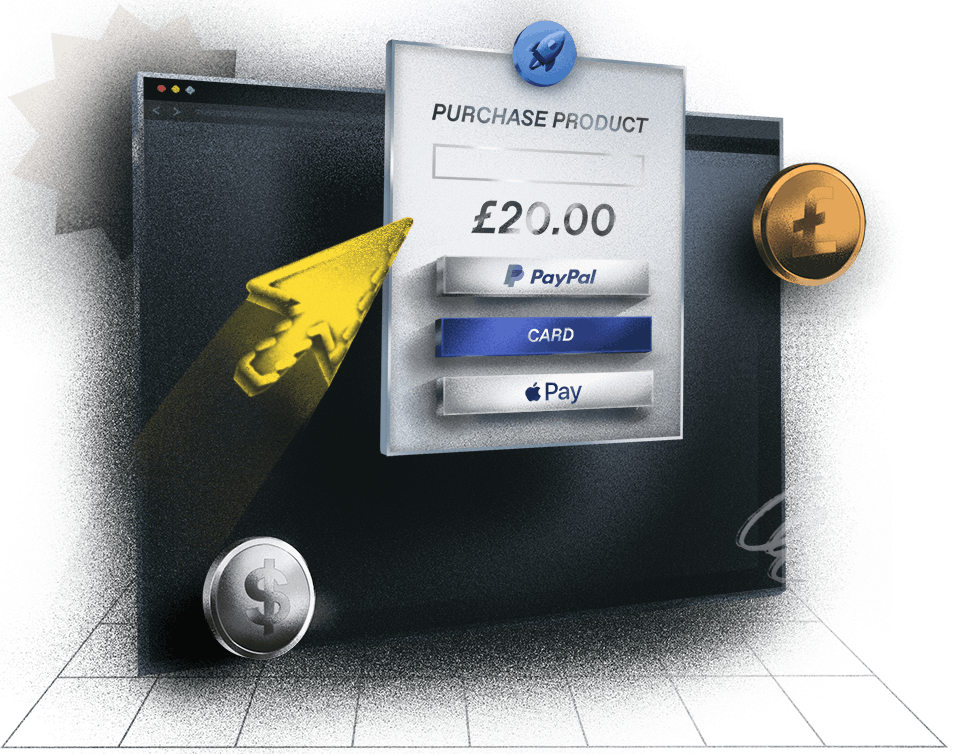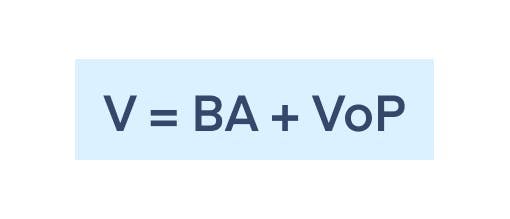Value-based pricing is a popular choice for SaaS businesses but it’s important that you put in the time and effort to know exactly how to make it work for your business, otherwise it’ll come back to bite you.
We’ve pulled together this guide to help you on your way to reaping the benefits of what can be an incredibly rewarding pricing strategy.
Here’s everything you need to know about value-based pricing.

What is value-based pricing?
Value-based pricing is where businesses price their product based on its perceived value by their customers, instead of basing it on production costs (plus the standard competitive markup for profit).
With value-based pricing, the price point that your customers are willing to pay is influenced by how successfully you build your brand and/or frame the value proposition of a given product. It’s not about the quantity of features on offer or even necessarily the quality of the product.
A great example is art. You’ve got a canvas, you’ve got some paint, you make some art.
The glitch is that, even if you’ve created something that Picasso would be proud to put his name on, you are not actually Picasso. No one is going to fork out millions of dollars to pay for your art, no matter what it looks like.
Value comes down to the creator and the story behind them/the story they’ve built, and not the creation itself.
How is value-based pricing applied in SaaS?
The thing about SaaS is that you don’t play it like Picasso. You aren’t having to paint every individual software piece that you sell.
Software works differently.
Once your software has been developed, the costs for powering and maintaining it are only minimally affected by how much it’s being used. This means that you and your competitors don’t need to take unit production costs into account as a floor for your price point. You can make your profit by selling access to your software to hundreds of thousands of people at a lower price point, or to a handful of people for hundreds of thousands.
How do you know which route to go?
With value-based pricing, you need to clearly define and deeply understand your target audience so you both create, position, and price your product in a way that brings joy or relief that is – to them – worth the cost attached. How can you create a product that will impact their life for the better? Or make it seem like the obvious choice?
What to consider with value-based pricing
If you’re looking into a value-based pricing strategy, there are a few things you need to consider to work out if this is the right option for you.
We take a look into the whos, hows, whats, and whys (literally, just in a different order) that you need to consider before saying a firm ‘yes’ to this type of pricing strategy:
- What’s your target audience? You need to fully understand your target audience as a whole, and use segmentation to apply the appropriate value calculations to each type of customer. Of course, this segmentation will differ between B2C and B2B, which we will talk about more in a bit.
- How’s the market looking? What’s going on in the marketplace will undoubtedly have an impact on how much your customer will be happy to pay for a product - price it too high at the wrong time or when your competitors are lower, and you won’t see the traction you want.
- Who are you up against? To get a real sense of your perceived value, it’s essential to research your competitors and what they’re up to (and have been up to historically). This will provide great insight into your pricing strategy plan, particularly if you’re looking to take on value-based pricing as an option.
- Why are you unique? You also need to consider your differentiated worth - what makes you stand out from your competitors or what makes you the obvious choice. Some USPs could include having a niche product or service, your brand name already having a lot of value, being the best in your industry, or having top notch service and support available for your customers.
B2B vs. B2C segmentation
Firstly, it’s important to note how B2B businesses will segment their clientbase differently to B2C businesses. For example, a B2C business would be looking into different reasons individuals were using their services - segmenting into behavioural habits, age groups, industries they are working in.
A B2B software business can segment into usage or number of seats. This can still be at an individual level, but segments should mainly revolve around sizes of businesses like SMB, midmarket, and enterprise (for example).
For each specific segment, there will be a specific perceived value, and for each specific value, there needs to be a specific price tag. Conclusion: you need to be specific.
Six advantages of value-based pricing for SaaS businesses
We’ve already described value-based pricing as potentially a very rewarding strategy, but why is it considered the go-to pricing model for SaaS?
Here are six reasons:
1. Every revenue opportunity covered
Creating price points to suit each segment or target market and their perceived value, meaning more bases are covered and a greater audience can be reached. This is how to unlock some hidden revenue 🔐
2. Valuable research
The research needed to implement this pricing model not only contributes to figuring out your price point, but also to your broader knowledge of the industry and market - something that will continue to benefit you further down the line
3. Optimising your product
The process behind applying a value-based model helps you to develop a higher quality product as it is purely based on what your customers think, need and want
4. Encourages fantastic customer support
If the aim of the game is to listen to your customers, guess who’s going to get very good customer service reviews?
5. Future growth and success
Once you’ve nailed your perceived value for your specific target audiences, this strategy promises persistent and long-term revenue growth for the future
6. It’s a win-win
If done correctly (with the proper research), you are guaranteed more profit through selling your product with this additional value added on. Why? Because there are minimal costs required to expand your customer base, whether on an individual basis or more users in a company
How to set your value-based pricing
Okay, so now you know the basics of what to look at when considering value-based pricing. If it sounds like it’s right for you, then how are you going to apply these thoughts to defining your value?
The answer: analysis.
This is where the real research and hard work begins. As we’re not ones to leave you completely in the dark, here’s the kind of analysis we’re talking about:
1) Customer analysis
We’ve said a bunch of times already that it’s all about the customer. And it really is. It’s about how they view and value your product. Starting with the customer and perceived value, this pricing strategy’s last thought is the product itself.
You can easily find out some juicy bits of information about why businesses choose you through your current customer base - bring your prospective customers into it too! Get some meetings or phone calls in the diary, or even send out an email survey for a more in-depth account.
A simple yes or no answer will only get you so far when you’re trying to work out things like:
- What affects your customers’ willingness to pay?
- How much are they open to paying for your product or specific features?
- What price point does your product become both too cheap and too expensive?
Keep that happy (but profitable) medium, guys.
Here's an example:
Avast asked respondents to rank these five features:
Feedback from this survey + the details about their willingness to pay for these features = some seriously valuable data. This data provides information about your product that can be divided into four categories:
- Essential features: These are ranked as high priority by customers, but they have a low willingness to pay extra for them, because they feel like this is the core of the product
- Differentiator features: This is particularly useful when finding out what could be swapped between basic and pro tiers as it can tell you what sets you apart from the competitors. You can see where there is a high value and high willingness to pay, justifying a higher price tag
- Add-on features: Think about your niche features that you know your customers are willing to pay for - these could very easily be packaged as add-ons that you price separately which is an easy way for more $$ (but also makes your product appear less pricey initially - clever)
- Fruitless features: These are the features that add no value to the product, and are potentially disregarded when asked if customers would pay extra for them - and there we have a quick cut in your development or marketing budget!
With all this, you’ll be able to better understand where you can charge more for certain features and how to market your product in the most profitable way. Maybe your data will even point you in the direction of pricing up your product all together, or perhaps in the direction of making a pro version for a higher cost?
You won’t know until you’ve done the research.
2) Total market analysis
This is where you take a deeper dive into your total addressable market that you’re about to head into.
This feeds into your customer analysis, but does have more of a focus on the customers you haven’t yet attained or the new target markets that you haven’t gone after yet. How will they view your product if it’s entirely new to them? What will make them think ‘wow, I need that’.
Consider every stage of the buying process when you’re segmenting your entire audience, and use tiered pricing to peak optimum interest between the tiers - just like Avast did with their pricing plan.
Oh, and you can’t go wrong with some quotes from industry players saying how great they think your company is either, highlighting the value businesses have gained since working with you.
3) Competitor analysis
Your final bit of analysis: who and what you’re up against.
These days, especially with software, there doesn’t tend to be a straight-up competitor. By that I mean, SaaS businesses make themselves niche for a reason, but elements of every business can often be replicated or similar elsewhere.
If you don’t have a direct competitor, consider every feature of your product and perform your competitor analysis through each one. Have a look at competing prices, reviews where you can find out what their customers are rating (and not rating), how they are promoting or marketing their product, and how they are encouraging brand loyalty.
You can do this through general research, (a big thank you to Google, LinkedIn, Crunchbase, and G2) but also through your current customers. Yep, that’s another good question for your survey or questionnaire.
Reach out and ask about other similar products or brands they’ve heard of, looked into, or maybe even moved over from. With this feedback, you can identify your own unique value proposition for your product, that sets yours apart from the rest. Get your product doing the job better than everyone else.
Make sure you’re keeping up to date on the latest trends too. With all this, you’re bound to get a good idea of the market as a whole, and create a price point that works.
Be ahead of the game. Poker face. 😎
How to calculate your perceived value
Now you’ve done the research and analysis, you should be able to ask yourself these questions and answer them intelligently and wholeheartedly:
- What do your customers value? What influences their willingness to pay?
- How can you let new or unknowing customers see the value of your software?
- What have your competitors been doing? And what are they currently doing?
Quiz time over. But if you couldn’t answer any of these questions, please return to the first section and start again because you just failed.
You really do need that research and analysis.
For those of you that passed our Paddle Pop Quiz, here’s the not-so-secret-but-secret-if-you-skipped-your-thorough-research-stage formula to work out value-based pricing:

In other words, your value is the sum of your brand advantage (what your product has over others or your USP, for example) and the end value of your product to the customer.
Understanding how your customers feel about your product, whether they have or haven’t been acquired yet, is so important to this calculation, but also to future pricing calculations. If you nail this pricing strategy first-off you can almost guarantee that the perceived value of your business (and not to mention brand loyalty) will increase over time. Magic.
Let’s talk a bit more about what a value-based pricing strategy can magic up for companies like yours…
How to implement value-based pricing
Now, what do you need to do when it comes to applying value-based pricing? Once the research and analysis is over, the hard work is pretty much done, and the experimentation can begin!
1) Create packages within the pricing plan
We’ve really hit home about the whole customer segmentation thing, haven’t we? That’s because one of the first things you should be doing when you are looking into value-based pricing is divvying up your services into packages to suit each customer segment.
Create bundles that suit each segments’ perceived value of your product. This not only takes into account the customers’ need for your product, but also the price point that they’d be willing to spend for it.
By offering a range of packages in your pricing plan, you appeal to a greater audience, at the same time as giving yourself the opportunity to upsell to clients further down the line.
Framer’s pricing plan, which we mentioned above, is a great example of this with their Freemium, Standard and Teams pricing, leading into a further detailed tiered pricing plan for different sized Teams.
2) Determine your price point
This is the main part of the experiment! After identifying and analyzing each buyer persona to work out your segments, you then need to apply the right price point for each.
Your research and analysis phase will undoubtedly help you towards this point, however, it’s important to remember that creating the optimal pricing plan can take time. There might be a few tweaks here and there, but keeping up to date with your customers will help you get there.
Leading us nicely onto our next point…
3) Communicate!
Keeping up communication with your customers is absolutely essential if you want to see success with a value-based pricing model. How else are you going to know what’s working (and what’s not working) for your clientbase?
It’s down to great customer service to listen out for what they’re saying, as well as great marketing to explain to your customers exactly what value you are providing.
4) Introduce your value-based pricing gradually
If you’re a SaaS business that has been going for a while, take your time introducing your new pricing strategy to your customers. Consider trying it out on a small selection of clients first, before applying it to your entire client base. Ideally, this selection should be made up of new clients that haven’t had any, or much, experience of your old pricing plans.
This way you can highlight any teething issues without it causing a mountain of work (and emails in your Support inbox) and get some good, honest, unbiased feedback. Lovely.
5) Keep up the good work
There’s very little point in introducing a value-based pricing strategy if you start to slack on delivering value once it’s in place.
The more you keep up the good work = the more value you are delivering to your customer = the more those customers will be willing to spend = the more customers want to know who you are, and try you out for themselves.
And there we have it - hard work really does pay off.
The disadvantages of value-based pricing
Like we’ve said, this pricing strategy isn’t one that works for all businesses. Sometimes it’s for reasons like, ahem… not being able to do our Pop Quiz, but sometimes it’s down to something out of your control. This specific strategy does come with its hurdles that not all businesses can jump over:
- Setting your perceived value is not easy: it’s tricky working out your perceived value, and the thing is, it does need to be strong for this strategy to work
- Difficult to set high value in early startup phase: as an early startup, you might hit roadblocks when it comes to acquiring customer data and feedback, but also acquiring a high value as a brand that’s never been seen or heard of before
- You can never be 100%: going by perceived is a science, but really, it isn’t an exact science - you can’t firmly predict everything
- Time and resource: we’ve made no secret of the hard work this takes up, and whilst it can be rewarding, not all businesses have the time and resources to put it in place
So yes, some would call these hurdles, some would call these sky-high, unclimbable brick walls and run in the opposite direction - and that’s okay. There are other great pricing strategies to choose from.
Choosing the right pricing method for your business
Your chosen pricing strategy is just so important as a growth lever for your business, which means you want to get it right.
Whilst it should be considered by everyone and adopted to some degree as an element in any pricing strategy, value-based pricing as a whole isn’t for everyone.
There are plenty of other pricing strategies out there to suit every type of business you can imagine.
Not sure where to start? We’ve got just the thing.




